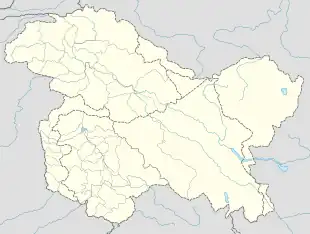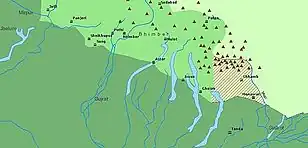Battle of Chumb
The Battle of Chumb was a major battle in the Western Front of the Indo-Pakistani War of 1971 fought between the Pakistan Army and the Indian Army in December 1971. Pakistan captured Chumb from India on the same principle as in the Battle of Chumb during Operation Grand Slam in 1965. The Pakistan Army's primary objective was to capture the town of Chumb and surrounding areas that had strategic importance for both Pakistan and India.[6][5][7]
| Battle of Chumb | |||||||||
|---|---|---|---|---|---|---|---|---|---|
| Part of the Indo-Pakistani War of 1971 (Western Front) | |||||||||
Top to bottom, left to right:
| |||||||||
| |||||||||
| Belligerents | |||||||||
|
|
| ||||||||
| Commanders and leaders | |||||||||
|
|
| ||||||||
| Units involved | |||||||||
unknown
|
| ||||||||
| Strength | |||||||||
| |||||||||
| Casualties and losses | |||||||||
|
72 killed 15 wounded Several tanks, artillery and military vehicles destroyed or captured 1 Hawker Hunter & 2 Sukhoi Su-7s damaged |
60 killed 80 wounded 4 tanks, several military vehicles destroyed 2 F-86F Sabres lost. | ||||||||
 Chamb Location of the battle with present−day geopolitical borders in the Kashmir region | |||||||||
Background
Before the capture of Chumb by Pakistan, this area was under India's control.
The town holds great strategic value. Similar to 1965, plans were made to capture this strategic town. The reason behind this plan was to deter Indians from attacking the crucial north-south line of communications passing via Gujrat.
The 23 Division of Pakistan was given the task of protecting this sector and later attacking the Chumb-Dewa sectors.
On the Indian side, the 10th Division was given the task of defence of Chamb; the Indian army believed that by attacking Gujrat and Tanda, they could guarantee the defence of Chamb. In comparison to 1965, the Indians were better prepared in terms of defences and now realized the importance of the town and sector.[11]
Strength
Brigadier Amar Cheema of the Indian Army, while comparing the strength of two countries during the battle, claimed that the Indian Armed Forces had superior tanks such as T-55 and T-54 who were equipped with 100 mm guns. They were said to be far superior to those of the Pakistani Type 59 tank.[1]
The Indian T-55 tanks also possessed APDS ammunition firing capability which the Pakistani Type 59 tanks did not have. The T-55 had a far superior stabilization system.[7]
Cheema also claims that there was near parity in terms of artillery but, when it came to infantry, the Pakistan army had fewer soldiers than the Indian army during the battle. He states that "it was this battle which helped in sustaining the morale of Pakistan army. The Indians, on the other hand, describe it as a most serious reverse suffered in the 1971 war".[1]
Outcome
The fierce battle led to thousands of civilians evacuating the area.[12]
Towards the end of the battle, the Indian Army hastily retreated from the area with little resistance, leaving behind entire volumes of sensitive documents and radios tuned to their respective codes.[12]
Under the Simla Agreement, signed between India and Pakistan on 2 July 1972, Pakistan retained the territory it captured in the Chumb sector.
References
- Brigadier Amar Cheema (2015). The Crimson Chinar: The Kashmir Conflict: A Politico Military Perspective. Lancer Publishers. pp. 297–298. ISBN 978-81-7062-301-4.
The contention that this was the most serious reverse for India in the war is also correct as it was here that Pakistan could maximise their territorial gains amounting to some 400 Sq. Km.... The way it ultimately planned out, Chamb was the only sector in J&K where the Indian forces suffered setback and this was attributable to Indian operational stance and inadequate preparation for the defensive battle for which the formation had been mandated.....Loss of territory in the sector for both sides was unacceptable, yet it was India who let this happen.
- Major General Jagjit Singh (1994). Indian Gunners at War:The Western Front 1971. Lancer Publishers. p. 88.
The saga of Chamb had come to an end. Despite defeat, 191 infantry brigade under the leadership of Brigadier Jasbir Singh (later Lieutenant General) had fought splendidly against, heavy odds.
- "Three Indian blunders in 1971 war". Rediff India. 11 December 2011.
In the 1971 war in Kashmir, Pakistan gained some territory in Chhamb as the Indian Army poised for an offensive was caught off guard by the Pakistani attack.
- www.webspider.pk, Web Spider (pvt) Ltd. "50 Years Celebrations of Pakistan's Victory in the Battle of Chhamb". www.hilal.gov.pk. Retrieved 2 November 2022.
- Kaiser Tufail (10 May 2010). "Air Support in Chamb – 1971 War". Aeronaut.
- LT COL MUHAMMAD MAJID MIRZA. "50 Years Celebrations of Pakistan's Victory in the Battle of Chhamb". Hilal English.
- Major (Retd) AGHA HUMAYUN AMIN. "The Battle of Chamb-1971". Archived from the original on 29 August 2000.
- "Armoured Corps History, 1971 war". Pakistan Army Website.
- "No. 26 Squadron PAF". PakDef.info. Archived from the original on 29 August 2012. Retrieved 20 July 2022.
- Major K.C. Parval (1987). Indian Army After Independence. Lancer Publisher. ISBN 9781935501619.
- Lt. Col. Muhammad Usman Hassan. "Battle Lore – On Breakthrough in Chamb". Soldiers Speak, Selected Articles from Pakistan Army Journal 1956–1981. Army Education Press, GHQ, Rawalpindi.
- Kamm, Henry (1971-12-13). "Pakistani Forces Take Ghost Town in Kashmir". The New York Times. ISSN 0362-4331. Retrieved 2023-04-23.
The Pakistani contention that the enemy left this side of the river in a rout is sustained by what they left behind. Entire volumes of records of the Sikh and Gurkha battalions that bore the brunt of the fighting were found in the large, neat camps from which they fled without destroying anything. On the ridgeline, the defenders left communication equipment tuned to their air and ground frequencies and did not bother to destroy their codes.
Further reading
- VSM, Brig Amar Cheema (31 March 2015), The Crimson Chinar: The Kashmir Conflict: A Politico Military Perspective, Lancer Publishers, pp. 297–, ISBN 978-81-7062-301-4



